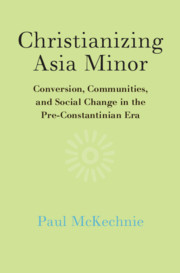Book contents
- Christianizing Asia Minor
- Christianizing Asia Minor
- Copyright page
- Contents
- Figures
- Abbreviations
- Preface
- Introduction
- 1 Phrygia in the New Testament
- 2 Hierapolis (Pamukkale)
- 3 Teachers of Asia: Ignatius, Polycarp, Paul and Thecla
- 4 Montanism Part 1: The Origins of the New Prophecy
- 5 Montanism Part 2: Pepuza and Tymion
- 6 Aberkios of Hierapolis (Koçhisar) and His Gravestone
- 7 Aberkios and the Vita Abercii
- 8 Apollonia (Uluborlu): Curiales and Their Families
- 9 Eumeneia (Işıklı) and the Eumeneian Formula
- 10 Christians for Christians
- 11 The Great Persecution and the Phrygian Fourth Century
- Book part
- Bibliography
- Index
4 - Montanism Part 1: The Origins of the New Prophecy
Published online by Cambridge University Press: 07 August 2019
- Christianizing Asia Minor
- Christianizing Asia Minor
- Copyright page
- Contents
- Figures
- Abbreviations
- Preface
- Introduction
- 1 Phrygia in the New Testament
- 2 Hierapolis (Pamukkale)
- 3 Teachers of Asia: Ignatius, Polycarp, Paul and Thecla
- 4 Montanism Part 1: The Origins of the New Prophecy
- 5 Montanism Part 2: Pepuza and Tymion
- 6 Aberkios of Hierapolis (Koçhisar) and His Gravestone
- 7 Aberkios and the Vita Abercii
- 8 Apollonia (Uluborlu): Curiales and Their Families
- 9 Eumeneia (Işıklı) and the Eumeneian Formula
- 10 Christians for Christians
- 11 The Great Persecution and the Phrygian Fourth Century
- Book part
- Bibliography
- Index
Summary
The New Prophecy (= Montanism), a movement which began about 170, originated in Phrygia, east of Philadelphia. Opponents found fault with the Montanists’ style of prophesying, but what they did was similar to prophecy in other Christian traditions. Priscilla and Maximilla, two women prophets, were key figures, along with Montanus, in the first Montanist generation. The Montanists based their church at Pepuza. According to Hippolytus, they wrote ‘countless books’ as well as carrying out missionary journeys to attract disciples. Montanus’ Odes may have been the Montanist hymnbook for almost four centuries. But Montanus, Priscilla, and Maximilla made their mark in less than a decade, Maximilla dying last, in or about 179. They built on an established prophetic tradition. At Thyatira, the church became Montanist from 172 to 263; and the New Prophecy spread far beyond Asia, to Lyon, Rome, Africa. The martyrs of Lyon (177) were influenced by Montanism, and a bishop of Rome acknowledged Montanist prophecies, before retracting his favourable judgement. At Pepuza, a hypogeum found in 2001 may (Peter Lampe argues) have been the burial place of Montanus and the prophetesses.
- Type
- Chapter
- Information
- Christianizing Asia MinorConversion, Communities, and Social Change in the Pre-Constantinian Era, pp. 96 - 122Publisher: Cambridge University PressPrint publication year: 2019



